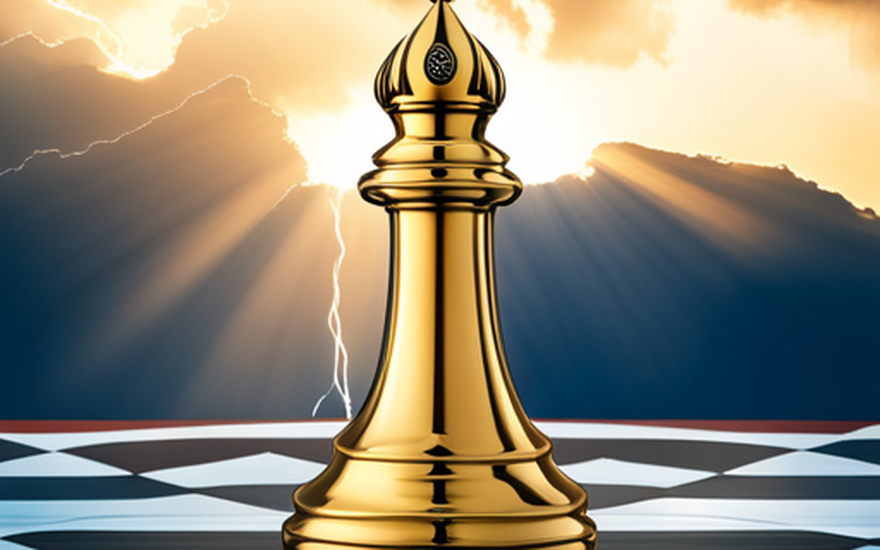
Stability.ai generated
Understanding your Bishops - The good, the bad and the active(not ugly)!
This blog will help you to make better use of your bishops in a chess gameIn this blog, we will understand the good bishop, the bad bishop, and the active bishop.
(We will cover - the double bishop advantage and when to exchange a bishop for a knight, and when not to in the next blog).
A bishop is usually compared with a knight as both bishop and knights are worth 3 points.
First, let us understand the pros and cons of a bishop.
Advantages:
1. A bishop is a long-range piece. This means that the bishop can sit at one corner of the board and create threats at the other end of the board. In the below example, we see that the bishop stops the opponent's pawns from queening and also helps to queen its pawns. The knight can do only one of these functions.
2. Bishops are stronger than knights in open positions as they can control more squares. (In chess open positions occur more than closed positions)
3. Two bishops are a great asset that can be used to attack your opponent.
4. Alpha Zero, the strongest chess player/AI/software in the world prefers the bishops over knights.
5. Whenever the exchange sacrifice is carried out, in the majority of the cases the rook is sacrificed for the bishop as the bishop's ability to attack/defend can sometimes outweigh the functionality of the rook.
6. Rook and bishop is a better combination than rook and knight. (Rook and bishop, both are long-range pieces and can coordinate better than a rook and knight).
Disadvantages:
1. A bishop can move only on one color complex. This severely limits the ability of the bishop.
2. Knights are superior to bishops in closed positions thanks to their ability to hop and move on both color complexes.
3. Queen and Knight is a better combination than Queen and bishop.
4. Bishops can be blocked easily and can become bad bishops if the pawns end up in the same color as the bishops.
5. Rook pawn endgames should be calculated correctly as the wrong color rook-pawn could end in a draw. In the below example, we see that the black king cannot be pushed out of the h8 queening square and hence, the game will end in a draw.
Good Bishop:
- A bishop is generally considered a "good bishop" if its central pawns (or flank pawns in the absence of central pawns) are placed on the opposite color of the bishop and not obstructing the bishop's diagonals.
In this case, the pawns control one color complex while the bishop controls the other, enabling greater control of the squares.
- A good bishop is determined based on the location of it's pawns. In general, we do not move the bishop, but instead, we move the pawns to the opposite color to make the bishop a good bishop. Only in the case where the pawns are fixed, we try to move the bishop to an open diagonal.
Bad Bishop:
A bishop is generally considered a "bad bishop" if its central pawns (or flank pawns in the absence of central pawns) are placed on the same color as the bishop and restrict the bishop's activity. Some players jokingly call the bad bishop a "big pawn" to point out that the bishop performs the job as a mere pawn.
- If the bishop is locked inside the pawn chain, then the bishop is left without active diagonals and it is considered bad.

Active bishop:
A bishop can be a good bishop or a bad bishop, but if it is performing a useful function, we can consider it an active bishop. The active bishop is almost the equivalent of a good bishop. This is a little bit counter-intuitive and confusing, so let me provide some examples:
- In the below position, most of the pawns are present on the same color as blacks light square bishop. However, the light-squared bishop is doing fine as it is present outside the pawn chain and it is controlling some vital squares.

- In the below position, despite having most of Black's pawns on the same color as the bishop, the bishop on e5 performs a useful task of attacking h2 and also controls the movement of the e4 pawn. The white bishop, even though it is a good bishop, is inferior to the black bishop as it is just shooting into thin air and not performing any useful function.

- In the below position, black is pawn down and he has a bad bishop and white has a good bishop. Still black is winning as the black bishop guards all the pawns whereas the white bishop is unable to guard any of its queenside pawns

Now we come to the question: Where should we place our bishops to maximize their use?
1. Bishops should be placed on open diagonals so that they can control many squares.
2. Bishops should be placed outside the pawn chain so that their movement is not restricted by the pawns.
3. Bishops can also be fianchettoed - the bishop is placed on the longest diagonal on the chess board which exerts a lot of pressure on the opponent's pieces (However, the drawback of fianchettoing your bishop is that the squares become weak if the bishop has been traded off).
4. The general suggestion is to have one bishop closer to your king while the one can be moved further into the opponent's territory.
5. If you have a bishop and your opponent has a knight, try to open up the center. Bishops love open positions!
6. Try to place your pawns on the color opposite to that of your bishop. This way, the bishop controls one color complex and the pawns control the other color complex.
7. There are no ideal or specific squares for the bishop. The bishop can do well in the center, but it does well when it is in the 2nd or 1st rank as well as it is a long-range piece.
Alphazero - Stockfish 8, 1-0
Please note that the above points are given based on general considerations and apply to most of the positions, but, bear in mind that in chess, there are exceptions to every rule given.
Now, here are some great quotes about bishops given by great players:
- All lines of play which lead to the imprisonment of the bishop are on principle to be condemned. — Siegbert Tarrasch
- Only a good bishop can be sacrificed, a bad bishop can only be lost. — Yuri Razuvaev
- With opposite coloured bishops the attacking side has in effect an extra piece in the shape of his bishop. — Mikhail Botvinnik
- Most chess players know, thanks to the study of master games, that two bishops are stronger than two knights or than bishop and knight, though very few know the reason for this advantage and how to turn it to account. — Richard Reti
- As Rousseau could not compose without his cat beside him, so I cannot play chess without my king's bishop. In its absence, the game to me is lifeless and void. The vitalizing factor is missing, and I can devise no plan of attack. — Siegbert Tarrasch
Now, we come to the final part - the training part to see if the above discussion was useful for your game:
Puzzle 1: White to play - Find the best move for White (Black's last move was e5)
Mark Dvoretsky vs. Y. Damsky
1-0 1970, Moscow URS, ECO: C00
Puzzle 2: Black to play - Find the best move for black (White's last move was Bh6)
Viktor Lyublinsky vs. Vladimir Simagin
0-1 Match 1939, Moscow URS, ECO: C46
Puzzle 3: Black to play - Black is in trouble. Find the best move for Black (White's last move was Re1)
Giorgio Porreca vs. David Bronstein
0-1 Belgrade, 1954, Round-10 ECO: B18
Puzzle 4: White to play - Find the best move for white (Black's last move was Ra7)
Robert James Fischer vs. Lhamsuren Miagmursuren
1-0 Sousse International, 1967 ECO: A07
The solutions for the above positions will be posted shortly.
This is my second blog. So please bear with me if you find any nuances.
Please feel free to post your answers to the puzzles in the comments. This would help me to get some motivation for more blogs in the future. Happy Reading and Improving!

